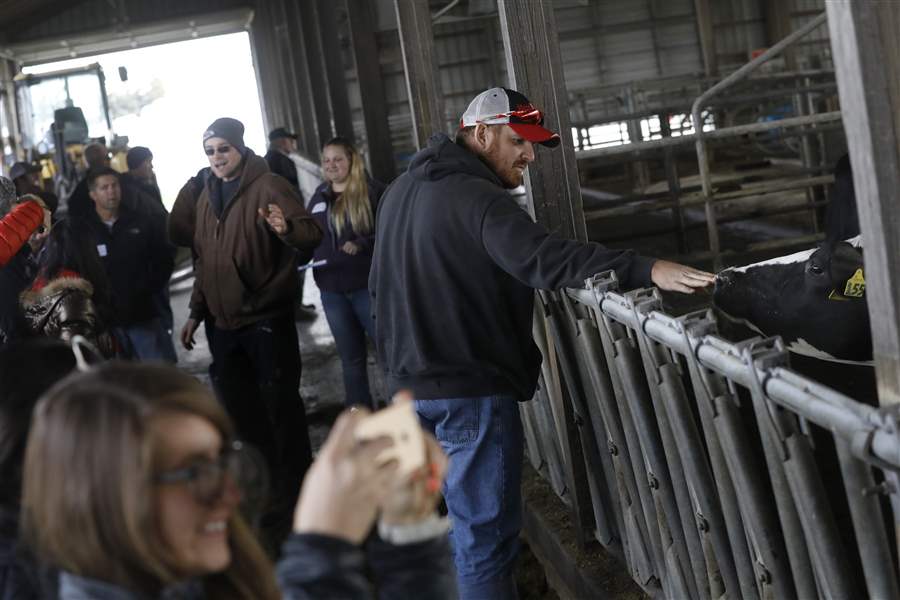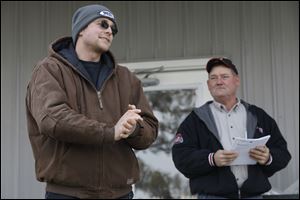
New tech on display at area farms during tour
11/14/2017
Genoa farmer Chad Gargas, center, reaches out to touch one of the milking cows as he and about 60 other people listen to dairy farmer Willem Van Rooijen, center left, talk about his operation during a tour of Naomi Dairy Tuesday in Cygnet.
THE BLADE/KATIE RAUSCH
Buy This Image
GIBSONBURG, Ohio — You’ve heard it all before: Farmers are stuck in their ways.
Except they aren’t.
From self-driven tractors to satellite technology being used to help inject fertilizer, dozens of people got to see for themselves Tuesday how science is becoming more sophisticated on northwest Ohio farms.
Although agricultural runoff is still believed to be responsible for as much as 87 percent of the algae-growing phosphorus that gets into western Lake Erie and its tributaries, the Nutrient Bus Tour shed light on steps being taken to improve efficiency and, thus, keep those nutrients in the soil. It was presented for a second consecutive year by soil and water conservation districts in Lucas, Seneca, Sandusky, Ottawa, and Wood counties, Beth Diesch, Seneca Conservation District spokesman, said.
Many of the presentations focused on newer technology.
Green Field Ag, a Gibsonburg-area business that sells technology to farmers, has used GPS and other technology to help tractors steer themselves since 2003, Matthew Liskai, Green Field Ag co-owner, said.
“If you have power steering on a tractor, we could probably get it to steer itself,” he said.
The company also has developed sprayers with smart technology to show what volumes of nutrients have been pumped into soil and when they’ve been applied, he said.
During a side conversation with Ohio Rep. Steve Arndt (R., Port Clinton) and a Blade reporter, 81-year-old Gibsonburg-area farmer Lee Havens confessed he doesn’t know a whole lot about the science that goes into transmitting incredibly sharp, digital images from drones to computers.
But he said he does understand how extreme closeups of his field give him a bird’s-eye view of how his crops are faring and where insects are causing the most trouble. That can help him become even more selective about what he puts on his land.
“I’m a nut for GPS, too,” Mr. Havens said with a chuckle. “Some people put their money into sailboats. I like GPS on my tractor.”
He introduced his granddaughter, Martha Winters, whom he said will be inheriting the family farm someday. He spoke with pride about the education she’s received in Purdue University’s world renowned agronomy department. She chimed in about her fascination for drone technology, and how she intends to use it more.
More than 120 people attended, divided evenly on two buses that alternated between sites in Cygnet, Gibsonburg, Fremont, and Graytown. Those attending included Toledo Mayor-elect Wade Kapszukiewicz; Genoa Mayor Ken Harsanje, Sr.; Mr. Arndt; Ottawa County Commissioner James Sass, Toledo Councilman Tyrone Riley, and Joe McNamara, an attorney in Toledo’s law department.
Mr. Harsanje was awestruck by the technology, saying there was nothing like it when he and his wife, Kim Harsanje, a master gardener, farmed 80 to 100 acres years ago.
“The technology today is amazing,” Mrs. Harsanje agreed.
During a morning stop near Fremont’s Tindall Bridge, Laura Johnson, director of Heidelberg University’s National Center for Water Quality Research, demonstrated how that lab has done the Great Lakes region’s oldest continuous sampling program since the 1970s.
She quoted Ohio Environmental Protection Agency data, which shows 9 percent of western Lake Erie basin watershed phosphorus comes from sewage treatment plants and combined sewer overflows, with another 4 percent from septic systems. Eight-seven percent comes from runoff, with agriculture by far the largest contributor to that category.

Dairy farmer Willem Van Rooijen, left, fields questions about his farm's operation as Jim Carter, District Technician with the Ohio Department of Agriculture's Soil and Water Conservation Division, listens during a tour of Naomi Dairy Tuesday in Cygnet.
At Naomi Dairy near Cygnet, farm manager Willem Van Rooijen, 29, discussed how 140 cows are managed on 310 acres. Though a large herd, it does not come close to the 700-cow figure that is used to distinguish Ohio dairy facilities as concentrated animal feeding operations, or CAFOs.
Mr. Van Rooijen described how manure there is captured and injected into fields that grow corn and other crops.
“Manure is a resource,” he said.
The final stop was at Fox Farms near Graytown, where the Ohio EPA issued a permit to Synagro to build a facility capable of holding 40,000 to 50,000 tons of Class B sludge generated by the city of Toledo before it is applied to area farms as nutrients. Much of it is applied directly without going into the state-approved warehouse, but most applications are limited to spring and fall.
The permit was issued by the state on April 20, 2016. The holding facility went into service on Sept. 8, 2016, Synagro representatives said.
Contact Tom Henry at thenry@theblade.com, 419-724-6079, or via Twitter @ecowriterohio.